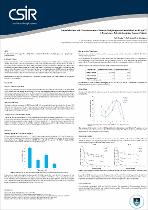 ResearchSpace
ResearchSpace
Immobilisation and characterisation of glucose dehydrogenase immobilised on ReSyn: a proprietary polyethylenimine support matrix
JavaScript is disabled for your browser. Some features of this site may not work without it.
- ResearchSpace
- →
- Research Publications/Outputs
- →
- Conference Publications
- →
- View Item
| dc.contributor.author |
Twala, BV

|
|
| dc.contributor.author |
Sewell, BT

|
|
| dc.contributor.author |
Jordaan, J

|
|
| dc.date.accessioned | 2010-10-04T11:25:19Z | |
| dc.date.available | 2010-10-04T11:25:19Z | |
| dc.date.issued | 2010-01 | |
| dc.identifier.citation | Twala, BV, Sewell, BT and Jordaan, J. 2010. Immobilisation and characterisation of glucose dehydrogenase immobilised on ReSyn: a proprietary polyethylenimine support matrix. 22nd South African Society for Biochemistry and Molecular Biology Congress. Bloemfontein, South Africa, 18-20 January 2010, pp 1 | en |
| dc.identifier.uri | http://hdl.handle.net/10204/4440 | |
| dc.description | 22nd South African Society for Biochemistry and Molecular Biology Congress. Bloemfontein, South Africa, 18-20 January 2010 | en |
| dc.description.abstract | Immobilisation of enzymes is of considerable interest due to the advantages over soluble enzymes, including improved stability and recovery. Glucose Dehydrogenase (GDH) is an important biocatalytic enzyme due to is ability to recycle the biological co-factor NAD(P)H)1 using the inexpensive substrate glucose. The ability to recycle co-factors is of importance due to the various biocatalytic applications of co-factor utilising enzymes2. These co-factors are expensive and not readily recoverable from biocatalytic systems. The adoption of a co-factor recycling system comprising of a cofactor regenerating enzyme has to an extent alleviated this drawback by greatly reducing the quantity of co-factor required. This work outlines the optimisation of ReSyn™ for protein binding and enzyme activity maintenance, with subsequent characterisation of the immobilised enzyme, GDH. The highest enzyme activity maintenance achieved for GDH was 42.3%, but varied greatly based on the degree of crosslinking of the polymer network. Lower degrees of crosslinking demonstrated lower enzyme activity maintenance. This was inversely proportional to the quantity of enzyme loading that could be achieved with higher loading being achieved with less polymer crosslinking. The immobilisation further broadened the pH range of the enzyme, particularly in the acidic pH range. | en |
| dc.language.iso | en | en |
| dc.subject | Glucose dehydrogenase | en |
| dc.subject | Immobilisation | en |
| dc.subject | ReSyn | en |
| dc.subject | Recycling | en |
| dc.subject | Biochemistry | en |
| dc.subject | Molecular biology | en |
| dc.title | Immobilisation and characterisation of glucose dehydrogenase immobilised on ReSyn: a proprietary polyethylenimine support matrix | en |
| dc.type | Conference Presentation | en |
| dc.identifier.apacitation | Twala, B., Sewell, B., & Jordaan, J. (2010). Immobilisation and characterisation of glucose dehydrogenase immobilised on ReSyn: a proprietary polyethylenimine support matrix. http://hdl.handle.net/10204/4440 | en_ZA |
| dc.identifier.chicagocitation | Twala, BV, BT Sewell, and J Jordaan. "Immobilisation and characterisation of glucose dehydrogenase immobilised on ReSyn: a proprietary polyethylenimine support matrix." (2010): http://hdl.handle.net/10204/4440 | en_ZA |
| dc.identifier.vancouvercitation | Twala B, Sewell B, Jordaan J, Immobilisation and characterisation of glucose dehydrogenase immobilised on ReSyn: a proprietary polyethylenimine support matrix; 2010. http://hdl.handle.net/10204/4440 . | en_ZA |
| dc.identifier.ris | TY - Conference Presentation AU - Twala, BV AU - Sewell, BT AU - Jordaan, J AB - Immobilisation of enzymes is of considerable interest due to the advantages over soluble enzymes, including improved stability and recovery. Glucose Dehydrogenase (GDH) is an important biocatalytic enzyme due to is ability to recycle the biological co-factor NAD(P)H)1 using the inexpensive substrate glucose. The ability to recycle co-factors is of importance due to the various biocatalytic applications of co-factor utilising enzymes2. These co-factors are expensive and not readily recoverable from biocatalytic systems. The adoption of a co-factor recycling system comprising of a cofactor regenerating enzyme has to an extent alleviated this drawback by greatly reducing the quantity of co-factor required. This work outlines the optimisation of ReSyn™ for protein binding and enzyme activity maintenance, with subsequent characterisation of the immobilised enzyme, GDH. The highest enzyme activity maintenance achieved for GDH was 42.3%, but varied greatly based on the degree of crosslinking of the polymer network. Lower degrees of crosslinking demonstrated lower enzyme activity maintenance. This was inversely proportional to the quantity of enzyme loading that could be achieved with higher loading being achieved with less polymer crosslinking. The immobilisation further broadened the pH range of the enzyme, particularly in the acidic pH range. DA - 2010-01 DB - ResearchSpace DP - CSIR KW - Glucose dehydrogenase KW - Immobilisation KW - ReSyn KW - Recycling KW - Biochemistry KW - Molecular biology LK - https://researchspace.csir.co.za PY - 2010 T1 - Immobilisation and characterisation of glucose dehydrogenase immobilised on ReSyn: a proprietary polyethylenimine support matrix TI - Immobilisation and characterisation of glucose dehydrogenase immobilised on ReSyn: a proprietary polyethylenimine support matrix UR - http://hdl.handle.net/10204/4440 ER - | en_ZA |





